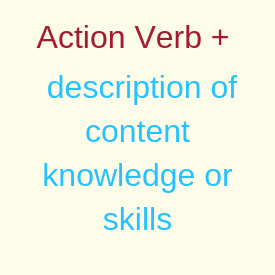
Creating learning outcomes is the first step in course design. A learning outcome is an observable, measurable skill or body of knowledge which a student should be able to demonstrate upon successful completion of a course. Each outcome should be specific, measurable, and written using behavioral verbs. Outcomes guide teaching, learning and assessment.
- Establish course goals
- Develop instructional strategy
- Select instructional materials
- Develop assignments and assessments at appropriate Bloom's level
- Improve curriculum alignment (assignments, assessments, etc.)
Good outcomes are SMART.
Specific-Outcome clearly states, so anyone reading it can understand what will be done.
Measurable-Outcome is measurable.
Achievable-Outcome is realistic.
Relevant-Outcome makes sense.
Time-bound-Outcome can be completed by the end of the course.
Upon successful completion of the course, students will be able to:
- Summarize reasons to write persuasively.
- Explain what constitutes effective management in a business environment.
- Analyze an issue or trend that helped to shape the criminal justice profession.
Writing Course Learning Outcomes

1. Begin with a measurable action verb.
2. Follow with a description of content knowledge or skill.
Best Practices:
Use Blooms Taxonomy which identifies six levels of measurable educational outcomes.
Use the Outcomes Advisory Council's Outcomes Checklist .
This Learning Outcome Generator can help you write outcomes.
Best Practices
|
Needs Improvement: |
Why this needs Improvement: |
Better Outcome: |
|
Upon successful completion students will be able to: Examine and appraise works of art from the renaissance movement. |
This outcome uses two verbs. Only use one verb in an outcome. Select the highest level verb on Bloom’s taxonomy. If a student is expected to appraise art work (highest level of blooms), then it is assumed that they can examine (lower level of blooms). Select the highest level of Bloom’s Taxonomy. |
Upon successful completion students will be able to: Appraise works of art from the Renaissance movement. |
|
Upon successful completion students will be able to: Analyze aesthetic, social, cultural and historical art movements from prehistory to medieval time. |
This outcome is actually four outcomes and expects assessment of aesthetic, social, cultural and historical art periods. The or provides faculty freedom from assessing every attribute. Select “or” instead of “and”. |
Upon successful completion students will be able to: Analyze aesthetic, social cultural or historical art movements from prehistoric to medieval time. |
|
Upon successful completion students will be able to: Have the opportunity to learn effective communication skills. |
This is an objective not an outcome and it doesn’t include the attribute of a successful student. This isn’t a learning outcome. |
Upon successful completion students will be able to: Use technology to communicate effectively in a professional setting. |
|
Upon successful completion students will be able to: Have an appreciation for communication practices. |
This outcome doesn’t start with an action verb nor defines the level of learning. This is too vague and not measurable. Avoid words like appreciation. |
Upon successful completion students will be able to: Use technology to communicate effectively in a professional setting. |
|
Upon successful completion students will be able to: Demonstrate knowledge of communication in a professional environment.
|
This outcome may start with a measurable verb, but doesn’t define a level of learning. It is too vague. Words like understand and understanding should not be used for learning outcomes. This is too vague. Words such as learn, understand and knowledge are not measurable. |
Upon successful completion students will be able to: Use technology to communicate effectively in a professional setting. |
Resources
1. Article: Writing Learning Outcomes
2. Article: The Role of Learning Outcomes in an Accreditation Quality Review – Beno (2003)
3. Article: Learning Outcomes Assessment in Community Colleges – Nunley, Bers, & Manning (2011)
4. PPT: Writing Learning Outcomes
5. Checklist: Outcomes Checklist
6. Tool: Learning Outcome Generator
7. Tool: CurricuNET - look up current course outcomes
8. Manual: Curriculum Council Procedures Manual - process to officially update outcomes
This page is licensed under a Creative Commons Attribution-Noncommercial 4.0 International License.
Learning Outcomes Assessment for Registered Faculty
If you are a registered Assessment Bootcamp faculty member, complete the Learning Outcomes Assessment before proceeding to Introduction to Assessment.
Assessment Bootcamp
The next lesson provides an introduction to assessment.
